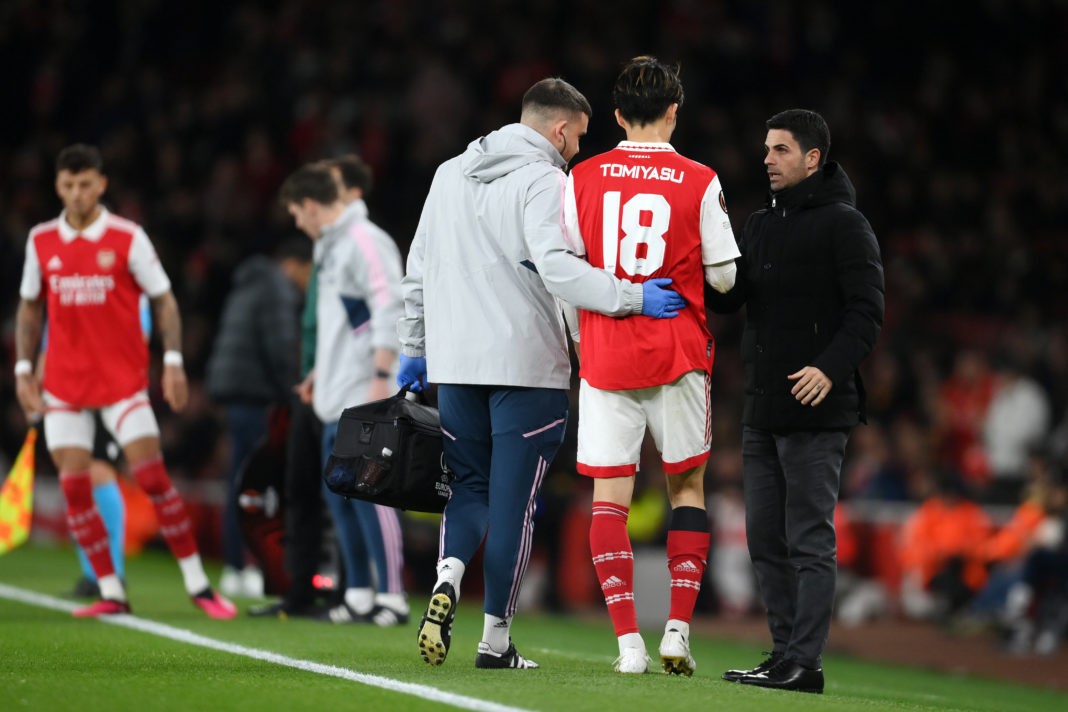Arsenal have confirmed that Takehiro Tomiyasu will miss the rest of the season after undergoing surgery on the knee issue he picked up on Thursday against Sporting.

According to a statement on Arsenal.com, Tomiyasu suffered a significant right knee injury, leading to successful surgery in London on Tuesday.
While Arsenal have no provided any further information on the type of injury suffered, they expect him back in training ahead of the new season.
You can see below the standard timeline for each type of knee injury:
| Knee & Leg injuries | Anterior Cruciate Ligament (ACL) | 4-6 months | ||
| Cartilage Tear (meniscal tear) | 2-4 weeks | 4-6 weeks | 2 months + | |
| Lateral Collateral Ligament Sprain | 2-3 weeks | 4-6 weeks | 3 months | |
| Medial Collateral Ligament Sprain | 2-4 weeks | 4-8 weeks | 3 months | |
| Osteochondritis Dissecans (OCD) | 3-5 months | |||
| Patella tendonitis | 6 weeks | 3 months | 6 months + | |
| Posterior Cruciate Ligament | 4-6 weeks | 6-8 weeks | 3-4 months |
Recovery from ACL
When surgery is required for an ACL injury, the recovery process can be more complex and longer than for non-surgical treatments. Here are some key aspects of the recovery process after ACL surgery:
- Post-operative rehabilitation: After surgery, the patient will work with a physical therapist to create a rehabilitation program. This will typically involve exercises to improve range of motion, strength, and balance. The rehabilitation program will be tailored to the patient’s individual needs and will evolve over time as the patient progresses.
- Use of crutches: Patients will likely need to use crutches for the first few weeks after surgery to avoid putting weight on the knee.
- Use of knee brace: A knee brace may be prescribed to help protect the knee and provide support during the early stages of recovery.
- Pain management: Pain management strategies, such as ice and pain medication, may be used to help manage pain during the recovery period.
- Gradual return to activity: Patients will gradually begin to reintroduce activity as their knee heals and their rehabilitation progresses. The timeline for this will vary depending on the patient’s individual recovery process and the type of activity being reintroduced.
- Follow-up appointments: Regular follow-up appointments with the surgeon and physical therapist are important to monitor progress and make any necessary adjustments to the rehabilitation program.
Overall, recovery from ACL surgery can take several months, and patients will need to be patient and diligent in following their rehabilitation program to achieve a successful outcome.
Recovery from MCL
The MCL (medial collateral ligament) is a ligament on the inside of the knee that helps to stabilize the knee joint. When the MCL is injured, it can lead to pain, swelling, and instability of the knee. In some cases, surgery may be required to repair or reconstruct the damaged ligament. Here are some key aspects of the recovery process after MCL surgery:
- Post-operative rehabilitation: After surgery, the patient will work with a physical therapist to create a rehabilitation program. This will typically involve exercises to improve range of motion, strength, and balance. The rehabilitation program will be tailored to the patient’s individual needs and will evolve over time as the patient progresses.
- Use of crutches: Patients will likely need to use crutches for the first few weeks after surgery to avoid putting weight on the knee.
- Use of knee brace: A knee brace may be prescribed to help protect the knee and provide support during the early stages of recovery.
- Pain management: Pain management strategies, such as ice and pain medication, may be used to help manage pain during the recovery period.
- Gradual return to activity: Patients will gradually begin to reintroduce activity as their knee heals and their rehabilitation progresses. The timeline for this will vary depending on the patient’s individual recovery process and the type of activity being reintroduced.
- Follow-up appointments: Regular follow-up appointments with the surgeon and physical therapist are important to monitor progress and make any necessary adjustments to the rehabilitation program.
Overall, recovery from MCL surgery can take several months, and patients will need to be patient and diligent in following their rehabilitation program to achieve a successful outcome. The timeline for recovery may vary depending on the severity of the injury, the type of surgery performed, and the individual patient’s healing process.

